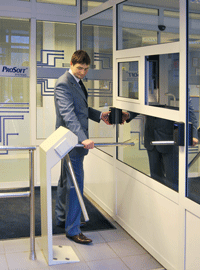|
Let's make a reservation right away: the classification by cost, which we will adhere to in this review, is quite arbitrary. Biometric readers can be divided according to many technical and technological features. Classification by cost is rather market-based. But we chose it because it is the price that largely reflects the technical excellence of the equipment, its functionality and reliability. In the first part of the review, we will consider the equipment presented in the budget price niche. But first, a few words about the biometric identification technologies used in security systems. Biometric identifiers, as is known, do not need to be specially manufactured. They are given to every normal person by nature. Moreover, they are unique for each person. Some of them are used in access control systems (ACS). The most well-known is fingerprint identification. Iris and retina identification, palm vein pattern, hand geometry, three-dimensional and two-dimensional face identification, etc. are also used. These are the biometric identifiers on which the so-called static identification methods are based — all the above parameters are static (unchangeable). Dynamic identification technologies, such as voice or handwriting identification, have not yet been widely used in classic ACS. Biometric readers used in ACS perform the functions of registration (saving a digital template of a biometric identifier in the system), identification (comparison of the identifier with all those in the database — 1 x N) or verification (comparison of one identifier with a template — 1 x 1). The reason fingerprint recognition technology is so well-known is not only because a method with the same name exists in forensics. By the way, there is a huge difference between these two methods. Fingerprint readers do not store the entire fingerprint, as is customary in classical fingerprinting, but use only a mathematical template or, as they say, a mathematical image of the finger. It is impossible to restore a complete fingerprint from it. Just as it is impossible to use a mathematical model of a finger anywhere except in access control and management systems. The reason fingerprint recognition technology is so widely known is that fingerprint-based ACS are the most common. In Russia, for example, their share is about 60% of the entire market for biometric access control and management systems. And the world market for biometric systems using fingerprint identification grew by 20–30% annually before the crisis. The advantages of biometric systems are obvious even to a non-specialist. The main one is that the analyzed characteristic is inextricably linked to a specific person, it is impossible to lose, transfer or forget it at home. Of course, fingerprint access control systems also have disadvantages. For example, there is the problem of protection against counterfeiting. Its solution largely depends on the type of sensor used in the reader. Sensors (or scanners) can be optical, capacitive, thermal, electromagnetic, ultrasonic. Optical and capacitive sensors are the most widely used in ACS. And it is these sensors that are mainly used in equipment presented in the price segments considered in this review. Budget readers The offer in this segment is quite large — anyone can verify this by running a corresponding search on the Internet. Another issue is that most models are essentially autonomous devices. However, there is equipment that, in addition to the standard Wiegand input, has the same output. That is, in principle, a network access control and management system can be built on their basis. They operate in verification mode, i.e. a preliminary reading of the card, tag or keyboard code occurs. Budget readers use optical sensors, which are much cheaper than capacitive ones. Low cost is an advantage, but, like any other cheap technology, it has its drawbacks. One of the main ones is low protection against counterfeiting. Capacitive silicon scanners (they are used in some models of budget readers) are much more difficult to deceive — here the natural moisture content of the finger is determined quite accurately. But there is also a drawback: capacitive scanners are critical to static electricity. That is, the scanner must be very well grounded. It would seem to be a simple task, but practice shows that grounding is often treated carelessly at facilities. The budget reader market is quite large in terms of the number of models offered. As for its monetary volumes, it is certainly inferior to other segments. In fact, today it is unlikely that anyone will give specific figures, there are no such studies. Therefore, all this is at the level of assumptions. For example, it is known that one of the Russian manufacturers stopped producing budget models due to low profitability. |
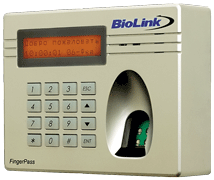
Biometric access control and timekeeping terminal Biolink FingerPass IC (BioLink) BioLink FingerPass IC terminals control any actuators, opening electromagnetic and electromechanical locks, turnstiles, gates upon presentation of a fingerprint, contactless card or PIN code by an authorized user. The listed identifiers can be used both individually and in various combinations. The terminal is also used to organize biometric accounting of working hours as part of the Biotime system. In the event of a failure in the local network, the terminal continues to function properly in autonomous mode, continuing to control access, storing information about events in the internal memory. When the network is restored, the accumulated information is automatically transmitted to the system server. The terminal is equipped with a display, keyboard, buzzer, and LEDs. The user is informed of the identification results using sound and color indication, as well as messages displayed on the display. |
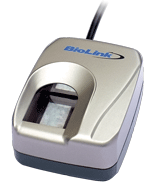
Office optical USB fingerprint scanner BioLink U-Match 3.5 (BioLink) BioLink U-Match 3.5 scanners are used for time tracking and WinLogon authentication (instead of a password). They are compact, ergonomic, and economical. They support Plug&Play technology and connect to a computer in seconds. Ready to use immediately after installing the software, accompanied by step-by-step instructions. BioLink U-Match 3.5 as part of the BioLink hardware and software complex performs both identification and verification of users, and the identification time for one person does not exceed 1 second. This fingerprint scanner is equipped with an optical sensitive element with a scanning area of 25.5 x 18 mm and a resolution of 508 dpi. |
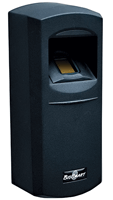
BioSmart biometric controller (Prosoft-Systems) BioSmart is an electronic module. Designed for fingerprint identification. The controller has non-volatile memory for recording fingerprints, as well as events that are recorded in chronological order with an indication of the exact time. The controller is equipped with a light indicator and an audible buzzer to inform the user about the identification results. The maximum number of fingerprints is 9000. The maximum number of events is 2800. The fingerprint scanner is capacitive. The probability of erroneous access FAR is no more than 0.0001%. False access denial probability FFR – no more than 0.001%. Identification time 1:1000 no more than 1 sec. Fingerprint data size – 256 ~ 384 bytes. Communication interface – RS485, 115,200 bps. Wiegand-26 interface: 1 input, 1 output. Non-volatile memory for the event log. 256-bit AES data encryption key. Maximum consumption 12 V DC, 250 mA. Overall dimensions (L x W x H) 175 x 75 x 54 mm. Temperature range: from -40 to +50 °C. There is a case opening sensor. |
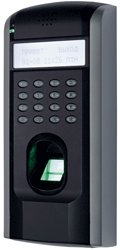
F702S fingerprint reader for 750 users (ZKSoftware) The F702S is equipped with a database of 1,500 fingerprint templates, so it can serve up to 750 users if two fingerprints of each employee are entered into the database. It can operate as part of a stand-alone or networked ACS with programming of functions via the built-in keyboard. Based on the F702S and the Russified software included in its delivery set, a centralized ACS can be organized, supporting an unlimited number of readers via Ethernet or RS-232 and RS-485 buses. This software allows you to program readers, enter users taking into account their access levels, monitor the ACS in real time, generate reports and display photos on the security monitor. In addition, the F702S has a Wiegand interface and supports user identification by PIN code plus code, by card plus code or only by card. |
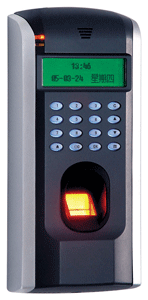
Fingerprint-F2000 – budget fingerprint reader with built-in controller Fingerprint-F2000 is equipped with a built-in controller, the memory capacity of which allows storing 500 fingerprint templates and 30,000 events simultaneously. The presence of a built-in controller in the design allows minimizing time costs and financial investments in the creation of autonomous access control and management systems, eliminating interruptions in the operation of the network ACS in the event of problems on the communication line. The system's performance also increases. Support for RS-485 and TCP/IP protocols allows the Fingerprint-F2000 to be used as part of large-scale network ACS, and the Wiegand26 interface makes it possible to connect this reader to controllers of virtually any well-known brand. During the Fingerprint-F2000 setup process, you can set the most suitable access mode for a specific access point – by fingerprint, by PIN code, by fingerprint and PIN code. It is possible to assign up to 50 time zones, specifying the appropriate mode and user group for each. The symmetrical body of the Fingerprint-F2000 makes the device equally convenient for both right-handed and left-handed users. The built-in LCD display simplifies the reader setup and diagnostics procedures. Alarm inputs/outputs allow you to instantly register attempts at unauthorized dismantling of the reader. |
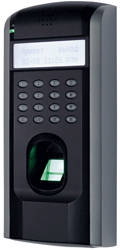
F7 Fingerprint Reader (ZKSoftware) This biometric reader is equipped with a database of 500 templates and is designed to operate as part of a stand-alone or networked ACS. F7 combines in one case an optical fingerprint scanner with a resolution of 500 dpi, a controller with a relay output for controlling the lock, a multi-color LED indicator, a keyboard and a display with a menu in Russian. It is programmed using the built-in keyboard and can use the Russified software included in its delivery set and supporting an unlimited number of readers via Ethernet or RS232/485. This software allows you to program readers, enter users into the database taking into account access levels, monitor the system in real time with photo output and report generation. In addition, the F7 has a Wiegand output, which allows it to be used as part of ACS from most manufacturers. The output Wiegand format can be arbitrarily configured by the user with a code length from 26 to 64 bits. |
